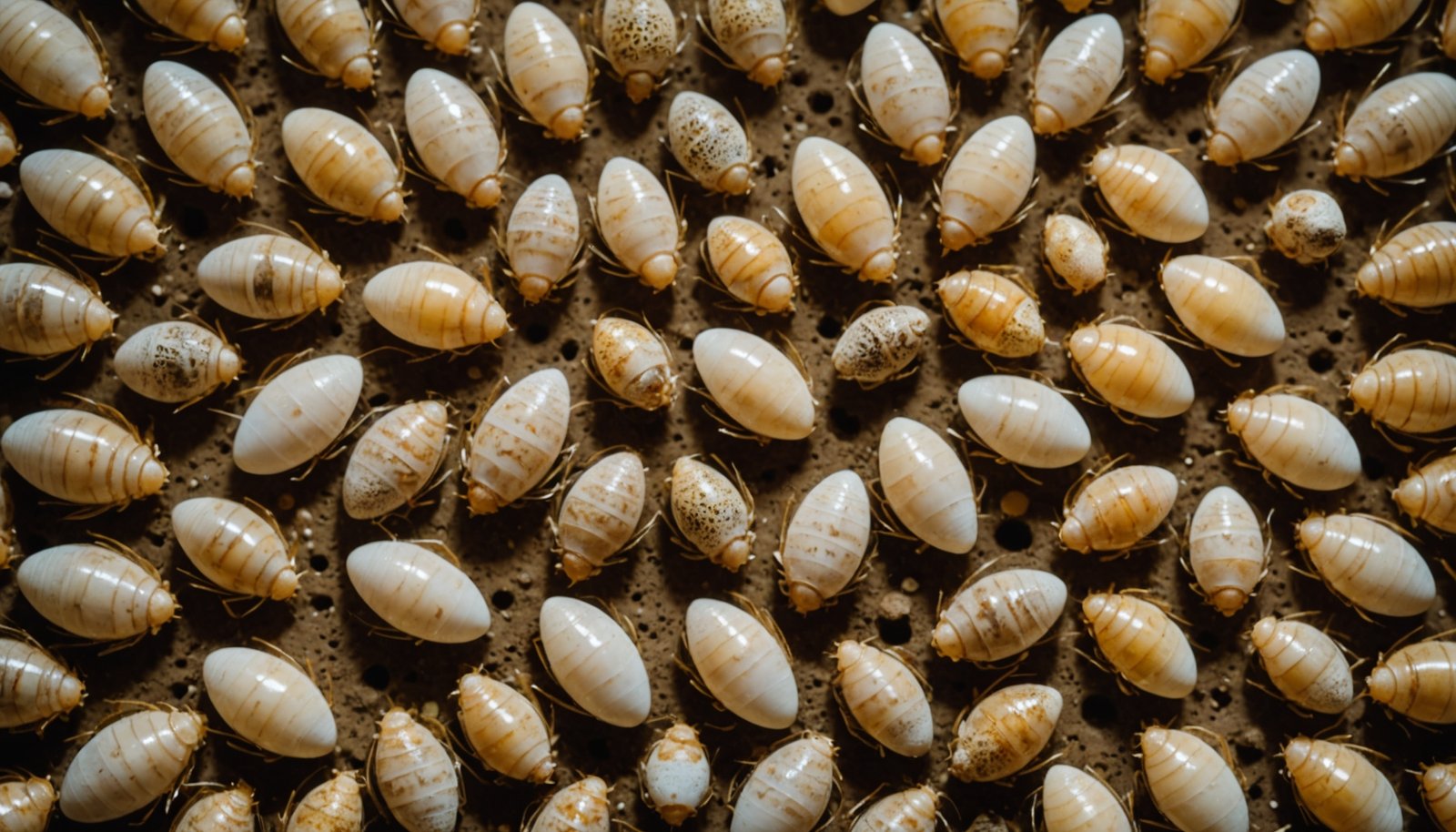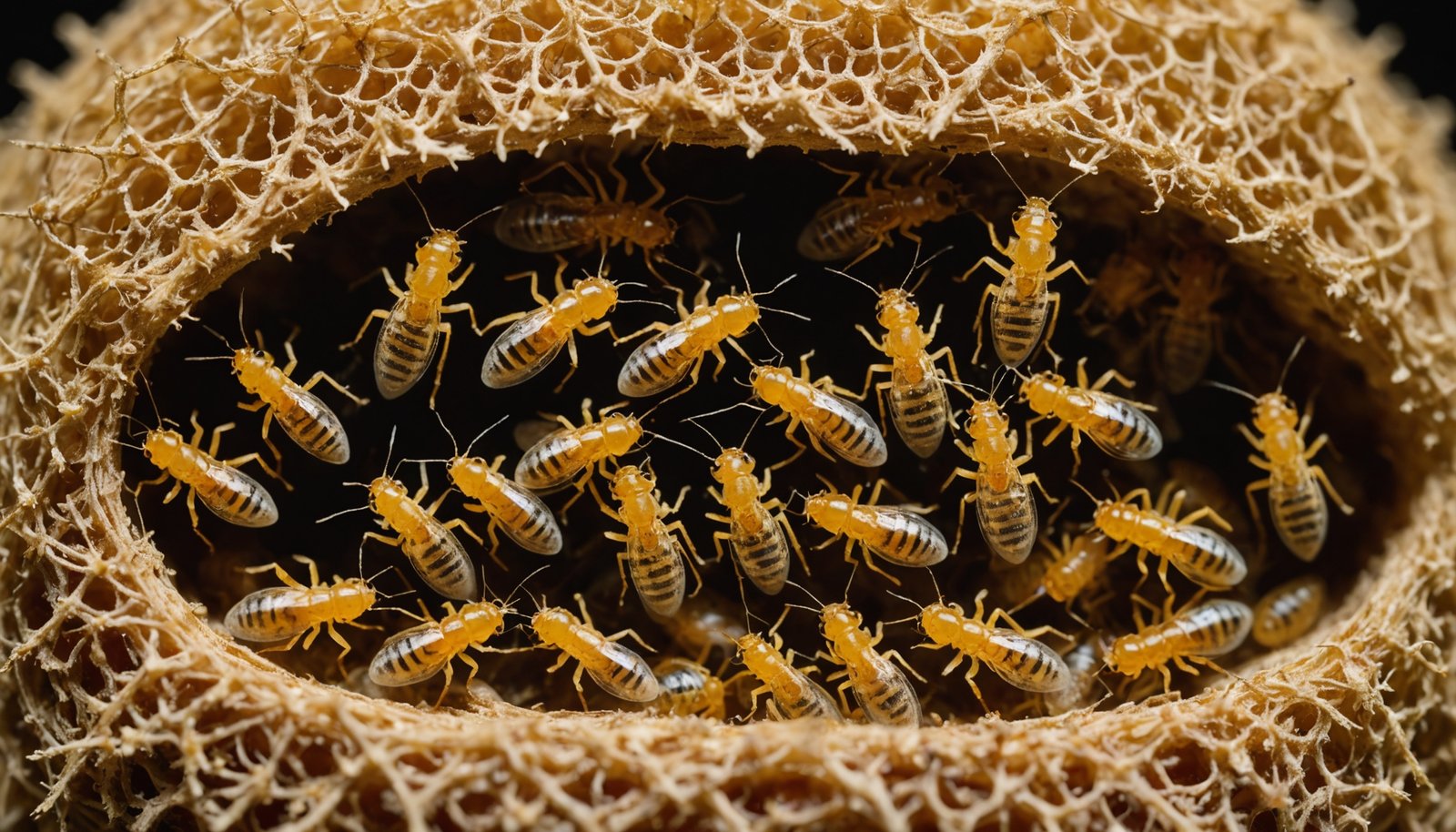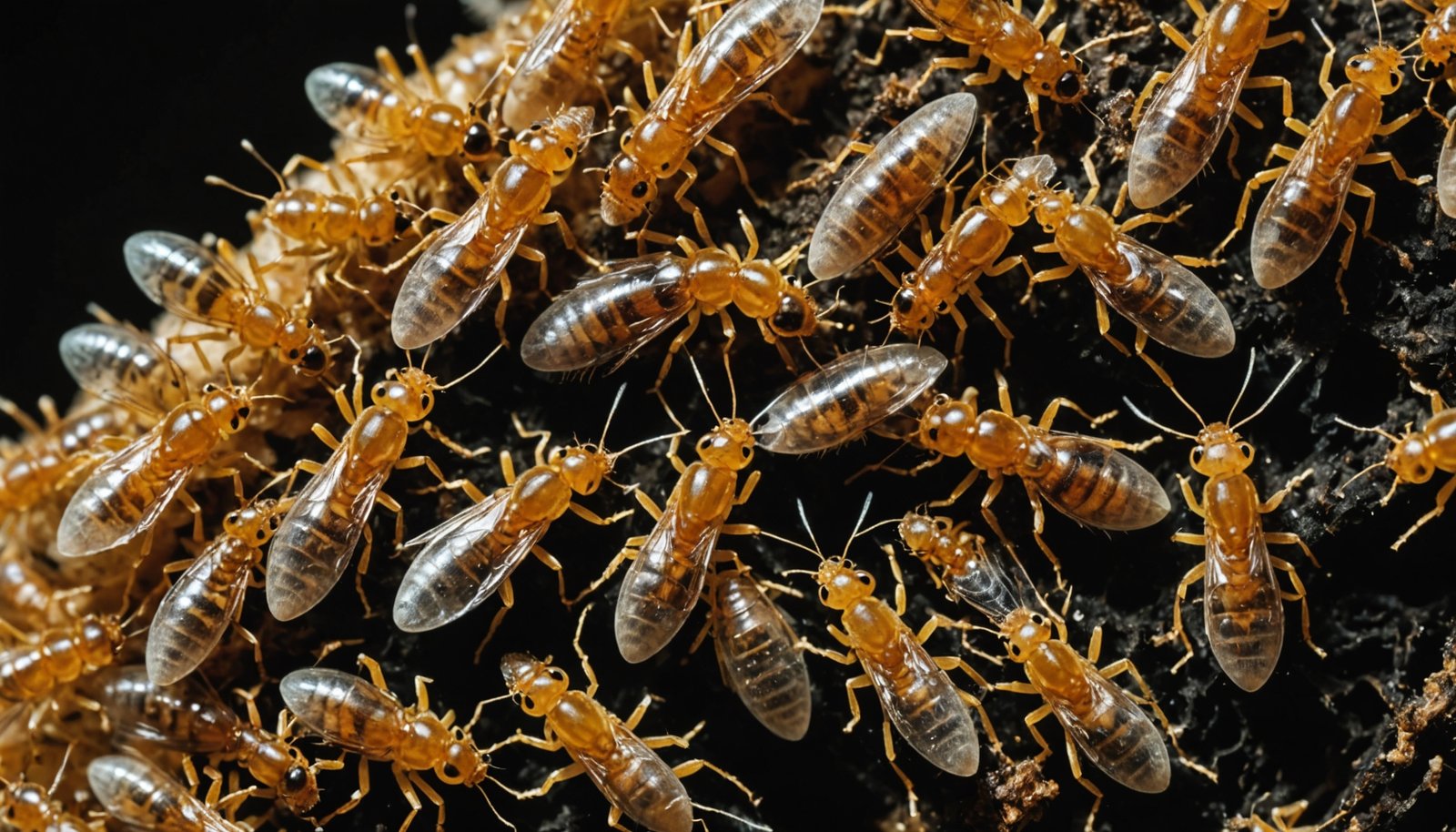Termite Lifecycle Explained: From Egg to Swarm
You’ll find termites begin their journey as one of thousands of eggs laid daily by the queen. Within two weeks, these eggs hatch into pale nymphs that molt and develop into specific castes – workers, soldiers, or reproductives. Workers maintain the colony while soldiers defend it. After 3-5 years, reproductive termites take flight during spring swarms to establish new colonies. Understanding this lifecycle reveals the complex world of these remarkable insects.
Key Takeaways
- Queen termites lay up to 30,000 eggs daily, which hatch into pale nymphs after 1-2 weeks of incubation.
- Nymphs undergo three molts and develop into specific castes: workers, soldiers, or reproductive alates.
- Workers perform essential colony tasks, while soldiers defend, and both support the growing population of termites.
- After 3-5 years, colonies produce reproductive alates that swarm during spring rainfall to establish new colonies.
- Only 10% of swarming termites survive, with successful females becoming queens and starting the cycle again.
The Royal Beginning: Queen’s Egg-Laying Process

One remarkable queen termite can produce up to 30,000 eggs daily, making her the powerhouse behind every thriving colony.
You’ll find that most of these eggs develop into worker termites, the backbone of the colony’s workforce, while a smaller portion becomes soldiers and future reproductives.
The colony’s success relies on this impressive reproductive system, where you’ll see members working together to protect and nurture the eggs.
The colony’s remarkable teamwork in safeguarding and caring for their eggs ensures the next generation’s survival and growth.
They’ll carefully tend to these precious deposits for one to two weeks until they hatch into nymphs.
As the queen continues her tireless egg-laying routine, the colony grows exponentially, potentially reaching millions of members over time.
This extraordinary reproductive capacity guarantees the colony’s long-term survival and maintains its vital structural integrity.
From Egg to Nymph: Early Development Stages

You’ll find thousands of termite eggs in the colony, appearing as tiny translucent jelly beans that take one to two weeks to incubate under the careful watch of worker termites.
Once hatched, the pale, translucent nymphs enter a critical growth phase where they’re completely dependent on worker termites for food and care.
These developing nymphs undergo up to three molts as they form their exoskeletons, preparing for their future roles as workers, soldiers, or reproductive termites within the colony.
Egg Development and Protection
While the termite colony bustles with activity, its queen dedicates herself to an astounding task: laying up to 30,000 eggs every day. These termite eggs are essential to the colony’s survival and growth, requiring careful protection and nurturing throughout their development.
The termite life cycle begins as workers tend to the eggs, which you’ll observe undergo several critical stages:
- Initial incubation lasting 1-2 weeks, during which the eggs are constantly monitored.
- Hatching into pale, translucent nymphs that rely completely on worker termites for food.
- Progressive development through multiple molts as the nymphs mature into their designated roles.
Worker termites guarantee the eggs’ survival by maintaining ideal temperature and humidity levels while protecting them from threats.
Most eggs will develop into workers themselves, though some become soldiers or future reproductives.
Nymph Growth and Molting
After emerging from their eggs, termite nymphs begin a remarkable transformation process that shapes their future roles within the colony.
You’ll notice these newly hatched nymphs appear translucent, with white or pale tan coloring. During their early development, they don’t feed on wood directly but rely on worker termites for nourishment.
The nymphs undergo up to three rounds of molting, where they shed their outer layer and develop a hardened exoskeleton.
This vital growth period determines their place in the colony’s caste system. As they mature, environmental factors and colony needs influence whether they’ll become workers, soldiers, or reproductive termites.
This systematic development guarantees the colony maintains its essential balance, with each member fulfilling specific roles necessary for survival.
Caste System Development and Social Structure

Much like a well-orchestrated society, termite colonies operate through an intricate caste system that guarantees their survival and growth.
You’ll find that each member plays an essential role, with the queen termite controlling the colony’s reproductive destiny through pheromones.
Here’s how the caste system functions:
- Workers (90-98% of the colony) handle most daily tasks, including feeding, grooming, and caring for young.
- Soldiers (2-4%) protect the colony from threats, serving as the dedicated defense force.
- Reproductive alates develop wings and leave annually to establish new colonies.
What’s fascinating is that this system isn’t rigid – workers can adapt to become secondary reproductives if needed, ensuring the colony’s survival even when the queen is gone.
This flexibility keeps the colony thriving through various challenges.
Worker and Soldier Roles in Colony Growth
The daily operations of a termite colony rest on two specialized groups: workers and soldiers. You’ll find worker termites dominating the population at 90-98%, performing essential tasks like nurturing young, food gathering, and tunnel construction. These eyeless, wingless members have soft, white bodies perfectly suited for their underground work.
| Colony Caste | Characteristics | Primary Functions |
|---|---|---|
| Workers | Soft white bodies, no eyes or wings | Food gathering, construction, brood care |
| Soldiers | Large brown heads, strong mandibles | Colony defense, threat protection |
Soldier termites, though only 2-4% of the population, are significant defenders with their distinctive brown heads and powerful mandibles. While they can’t feed themselves, these protectors rely on workers for sustenance. Together, these two castes create a balanced system that guarantees your colony’s growth and survival through their complementary roles.
The Reproductive Phase: Preparing for Flight
When mature colonies reach their peak, they produce specialized termites called alates – winged swarmers destined to establish new colonies. These reproductive termites undergo remarkable changes as they prepare for their significant mating flight, developing both pigmentation and functional eyes.
You’ll observe three key phases in this fascinating process:
- Spring emergence: Winged swarmers leave their colonies after rainfall, marking the start of the reproductive phase.
- Mass flight: Thousands take to the air, though sadly, only 10% survive predators and environmental challenges.
- Colony founding: Successful females shed their wings, become queens, and begin to lay eggs – starting with just 6-12 eggs but eventually producing up to 30,000 daily as the colony matures.
Swarming Season: Birth of New Colonies
You’ll notice termites launching their springtime swarms after rainfall, when thousands of winged reproductives take flight to establish new colonies.
The journey’s fraught with danger, as predators and harsh conditions eliminate most swarmers, leaving only the strongest pairs to mate and build new nests.
Once a queen finds suitable ground, she’ll shed her wings and begin laying up to 30,000 eggs daily, rapidly expanding her newly formed colony.
Ideal Conditions for Swarming
During spring months, termite colonies prepare for one of nature’s most remarkable events – the emergence of swarmers. When conditions turn warm and wet after rainfall, swarming termites take flight in massive numbers, seeking to establish new colonies.
You’ll often spot these winged reproductives gathering around your home’s light sources, signaling a mature colony nearby.
Here’s what you need to know about ideal swarming conditions:
- Warm, humid weather following spring rainfall triggers the emergence
- Colonies must be 3-5 years old before producing swarmers, indicating potential structural damage
- A successful swarm results in a new termite queen capable of laying up to 30,000 eggs daily
While thousands may emerge, only a small fraction survive to establish new colonies, making timing and conditions vital for their survival.
Colony Growth and Preparation
The birth of a new termite colony marks one of nature’s most fascinating cycles of survival. When you witness termite swarmers taking flight, you’re actually seeing the culmination of 3-5 years of colony development. These reproductive alates emerge by the hundreds, ready to establish new colonies and continue their species’ legacy.
Once a female finds her mate, she’ll shed her wings and begin her role as queen. As the queen lays eggs, which can reach an impressive 30,000 per day, the colony starts to take shape.
Worker termites join the royal pair to care for the larvae, creating a self-sustaining system. You’ll find that successful termite colonies demonstrate remarkable efficiency, with each member playing a crucial role in preparing for future generations of swarmers.
Dispersal and Colony Formation
Springtime signals the start of termite swarming season, when reproductive alates emerge en masse from their mature colonies.
You’ll witness hundreds or thousands of winged termites taking flight, especially after rainfall, though most won’t survive their perilous journey.
When successful reproductive termites find their mates, they’ll begin the fascinating process of establishing new colonies:
- Female swarmers shed their wings and search for suitable nesting locations
- A royal pair forms, with the queen beginning to lay eggs
- The colony expands rapidly as the queen produces 20,000-30,000 eggs daily
If you’re seeing swarming activity around your property, it’s vital to take notice.
This behavior typically indicates a mature colony has been active for 3-5 years, potentially consuming wood in your structure.
Conclusion
As you’ve learned about the termite’s journey from egg to swarming adult, you’ll better understand these remarkable insects’ complex social structure. You’ll recognize how each stage contributes to colony survival, from the queen’s initial egg-laying to the dramatic seasonal swarms. When you spot termites around your home, you’ll now know exactly where they are in their fascinating lifecycle.

